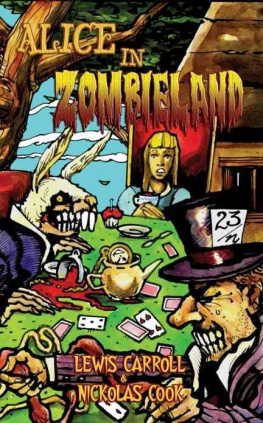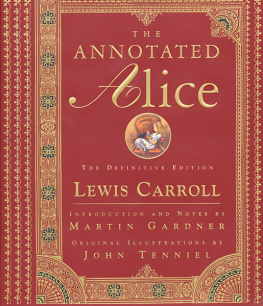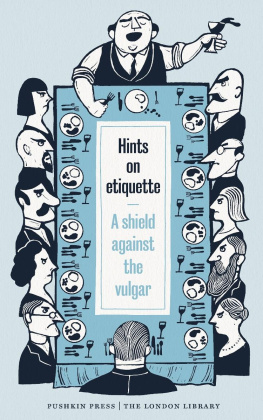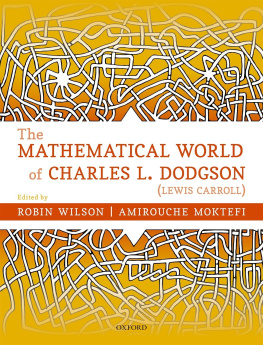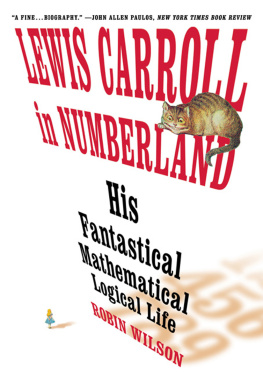Lewis Carroll - The Game of Logic
Here you can read online Lewis Carroll - The Game of Logic full text of the book (entire story) in english for free. Download pdf and epub, get meaning, cover and reviews about this ebook. year: 2003, genre: Children. Description of the work, (preface) as well as reviews are available. Best literature library LitArk.com created for fans of good reading and offers a wide selection of genres:
Romance novel
Science fiction
Adventure
Detective
Science
History
Home and family
Prose
Art
Politics
Computer
Non-fiction
Religion
Business
Children
Humor
Choose a favorite category and find really read worthwhile books. Enjoy immersion in the world of imagination, feel the emotions of the characters or learn something new for yourself, make an fascinating discovery.
- Book:The Game of Logic
- Author:
- Genre:
- Year:2003
- Rating:4 / 5
- Favourites:Add to favourites
- Your mark:
- 80
- 1
- 2
- 3
- 4
- 5
The Game of Logic: summary, description and annotation
We offer to read an annotation, description, summary or preface (depends on what the author of the book "The Game of Logic" wrote himself). If you haven't found the necessary information about the book — write in the comments, we will try to find it.
The Game of Logic — read online for free the complete book (whole text) full work
Below is the text of the book, divided by pages. System saving the place of the last page read, allows you to conveniently read the book "The Game of Logic" online for free, without having to search again every time where you left off. Put a bookmark, and you can go to the page where you finished reading at any time.
Font size:
Interval:
Bookmark:
The Project Gutenberg EBook of The Game of Logic, by Lewis Carroll(#6 in our series by Lewis Carroll)
Copyright laws are changing all over the world. Be sure to check thecopyright laws for your country before downloading or redistributingthis or any other Project Gutenberg eBook.
This header should be the first thing seen when viewing this ProjectGutenberg file. Please do not remove it. Do not change or edit theheader without written permission.
Please read the "legal small print," and other information about theeBook and Project Gutenberg at the bottom of this file. Included isimportant information about your specific rights and restrictions inhow the file may be used. You can also find out about how to make adonation to Project Gutenberg, and how to get involved.
**Welcome To The World of Free Plain Vanilla Electronic Texts**
**eBooks Readable By Both Humans and By Computers, Since 1971**
*****These eBooks Were Prepared By Thousands of Volunteers!*****
Title: The Game of Logic
Author: Lewis Carroll
Release Date: December, 2003 [EBook #4763][Yes, we are more than one year ahead of schedule][This file was first posted on March 13, 2002][Date last updated: May 10, 2004]
Edition: 10
Language: English
*** START OF THE PROJECT GUTENBERG EBOOK, THE GAME OF LOGIC ***
Scanned by Gregory D. Weeks
Transcribed by L. Lynn Smith
Proofed by Reina Hosier and Brett Fishburne
By Lewis Carroll
-|9 | 10|| | || -x || |11 | 12| || | | | ||-y-my'-|| | | | || |13 | 14| || -x'- || | ||15 | 16|
COLOURS FOR
COUNTERS |5 | 6|
___ | x |
| | |
See the Sun is overhead, |y-y'-|
Shining on us, FULL and | | |
RED! | x' |
|7 | 8|
Now the Sun is gone away,
And the EMPTY sky is
GREY!
___
By Lewis Carrol
To my Child-friend.
I charm in vain; for never again,
All keenly as my glance I bend,
Will Memory, goddess coy,
Embody for my joy
Departed days, nor let me gaze
On thee, my fairy friend!
Yet could thy face, in mystic grace,
A moment smile on me, 'twould send
Far-darting rays of light
From Heaven athwart the night,
By which to read in very deed
Thy spirit, sweetest friend!
So may the stream of Life's long dream
Flow gently onward to its end,
With many a floweret gay,
Adown its willowy way:
May no sigh vex, no care perplex,
My loving little friend!
With each copy of this Book is given an Envelope, containing aDiagram (similar to the frontispiece) on card, and nine Counters,four red and five grey.
The Envelope, &c. can be had separately, at 3d. each.
The Author will be very grateful for suggestions, especially frombeginners in Logic, of any alterations, or further explanations,that may seem desirable. Letters should be addressed to him at"29, Bedford Street, Covent Garden, London."
"There foam'd rebellious Logic, gagg'd and bound."
This Game requires nine Countersfour of one colour and five ofanother: say four red and five grey.
Besides the nine Counters, it also requires one Player, AT LEAST.I am not aware of any Game that can be played with LESS than thisnumber: while there are several that require MORE: take Cricket,for instance, which requires twenty-two. How much easier it is,when you want to play a Game, to find ONE Player than twenty-two.At the same time, though one Player is enough, a good deal moreamusement may be got by two working at it together, and correctingeach other's mistakes.
A second advantage, possessed by this Game, is that, besides beingan endless source of amusement (the number of arguments, that maybe worked by it, being infinite), it will give the Players a littleinstruction as well. But is there any great harm in THAT, so longas you get plenty of amusement?
I. NEW LAMPS FOR OLD. 1. Propositions....... 1 2. Syllogisms........ 20 3. Fallacies........ 32
II. CROSS QUESTIONS.
1. Elementary........ 37
2. Half of Smaller Diagram. Propositions
to be represented..... 40
3. Do. Symbols to be interpreted.. 42
4. Smaller Diagram. Propositions to be
represented....... 44
5. Do. Symbols to be interpreted.. 46
6. Larger Diagram. Propositions to be
represented....... 48
7. Both Diagrams to be employed .. 51
III. CROOKED ANSWERS.
1. Elementary........ 55
2. Half of Smaller Diagram. Propositions
represented....... 59
3. Do. Symbols interpreted... 61
4. Smaller Diagram. Propositions represented. 62
5. Do. Symbols interpreted... 65
6. Larger Diagram. Propositions represented. 67
7. Both Diagrams employed.... 72
"Light come, light go." _________
1. Propositions.
"Some new Cakes are nice."
"No new Cakes are nice."
"All new cakes are nice."
There are three 'PROPOSITIONS' for youthe only three kinds weare going to use in this Game: and the first thing to be done isto learn how to express them on the Board.
Let us begin with
"Some new Cakes are nice."
But before doing so, a remark has to be madeone that is ratherimportant, and by no means easy to understand all in a moment: soplease to read this VERY carefully.
The world contains many THINGS (such as "Buns", "Babies", "Beetles"."Battledores". &c.); and these Things possess many ATTRIBUTES(such as "baked", "beautiful", "black", "broken", &c.: in fact,whatever can be "attributed to", that is "said to belong to", anyThing, is an Attribute). Whenever we wish to mention a Thing, weuse a SUBSTANTIVE: when we wish to mention an Attribute, we usean ADJECTIVE. People have asked the question "Can a Thing existwithout any Attributes belonging to it?" It is a very puzzlingquestion, and I'm not going to try to answer it: let us turn upour noses, and treat it with contemptuous silence, as if it reallywasn't worth noticing. But, if they put it the other way, and ask"Can an Attribute exist without any Thing for it to belong to?", wemay say at once "No: no more than a Baby could go a railway-journeywith no one to take care of it!" You never saw "beautiful" floatingabout in the air, or littered about on the floor, without any Thingto BE beautiful, now did you?
And now what am I driving at, in all this long rigmarole? It isthis. You may put "is" or "are" between names of two THINGS (forexample, "some Pigs are fat Animals"), or between the names of twoATTRIBUTES (for example, "pink is light-red"), and in each case itwill make good sense. But, if you put "is" or "are" between thename of a THING and the name of an ATTRIBUTE (for example, "somePigs are pink"), you do NOT make good sense (for how can a ThingBE an Attribute?) unless you have an understanding with the personto whom you are speaking. And the simplest understanding would, Ithink, be thisthat the Substantive shall be supposed to be repeatedat the end of the sentence, so that the sentence, if written outin full, would be "some Pigs are pink (Pigs)". And now the word"are" makes quite good sense.
Thus, in order to make good sense of the Proposition "some new Cakesare nice", we must suppose it to be written out in full, in theform "some new Cakes are nice (Cakes)". Now this contains two'TERMS'"new Cakes" being one of them, and "nice (Cakes)" theother. "New Cakes," being the one we are talking about, is calledthe 'SUBJECT' of the Proposition, and "nice (Cakes)" the 'PREDICATE'.Also this Proposition is said to be a 'PARTICULAR' one, since itdoes not speak of the WHOLE of its Subject, but only of a PART ofit. The other two kinds are said to be 'UNIVERSAL', because theyspeak of the WHOLE of their Subjectsthe one denying niceness, andthe other asserting it, of the WHOLE class of "new Cakes". Lastly,if you would like to have a definition of the word 'PROPOSITION'itself, you may take this:"a sentence stating that some, ornone, or all, of the Things belonging to a certain class, calledits 'Subject', are also Things belonging to a certain other class,called its 'Predicate'".
Next pageFont size:
Interval:
Bookmark:
Similar books «The Game of Logic»
Look at similar books to The Game of Logic. We have selected literature similar in name and meaning in the hope of providing readers with more options to find new, interesting, not yet read works.
Discussion, reviews of the book The Game of Logic and just readers' own opinions. Leave your comments, write what you think about the work, its meaning or the main characters. Specify what exactly you liked and what you didn't like, and why you think so.


